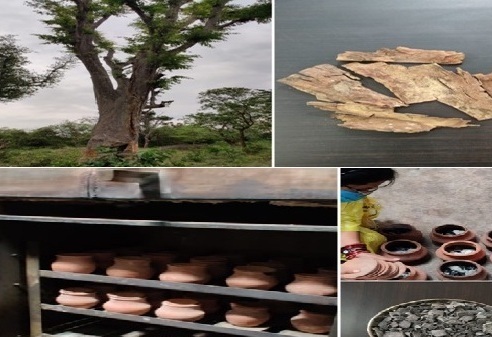Heavy Metal and Fluoride Removal from Synthetic Water Treated with Dhava (Anogeissus Latifolia Wall.) Bark Ash
DOI:
https://doi.org/10.47070/ayushdhara.v8i4.767Abstract
Being a universal solvent, water is a major source of contamination. According to the World Summit of Sustainable Development, the major reason for lack of safe water is either scarcity of water or contamination of water sources. The quality of water is vital concern for the man kind as it is directly linked with human welfare. Aim and Objective: To evaluate the Jala Shodhana properties of Dhava (Anogeissus latifolia Wall.) stem bark ash. Material and method: Authentification and collection of Dhava bark was done from renowned source. Dhava bark was calcinated in Muffle furnace and used for the further study. The filter was prepared by using sand, gravel and Dhava bark ash. Synthetic water sample prepared by adding Arsenic trioxide, lead acetate, Calcium fluoride and Mercury-II Sulfate. This synthetic water was analyzed by Atomic Absorption Spectrometry, to know the percent removal of Heavy metals and fluoride after the treatment by Dhava bark ash filtering apparatus. Result- The Dhava stem bark (filtering apparatus) shows significant result in removal of mercury (99.8%), lead (99.9%), Arsenic (34.18%) and Fluoride (57.05%) from water. Discussion: The present study was undertaken to assess the efficiency and pollution reduction potential of sand intermittent filtration technology in term of heavy metal. Filtration can be compared to a sieve or micro-strainer that traps suspended material between grains of filter media In this present research work efforts have been made to develop a low cost and low maintenance model of Bio-sand intermittent filtration for treatment of Dushita Jala. (BIO= Stem bark of Anogessious latifolia). Conclusion: This study proves the statement of Acharya Sushruta about Jala shodhana properties of Dhava described in Kalpa sthana Tritiya Adhyaya. Therefore our study will leads to the development of Bio-sand filter which is cost-effective without chemical operation and environmental friendly technology for water and waste water treatment.
Downloads

Downloads
Published
Issue
Section
License
Copyright (c) 2021 AYUSHDHARA

This work is licensed under a Creative Commons Attribution-NonCommercial-ShareAlike 4.0 International License.


